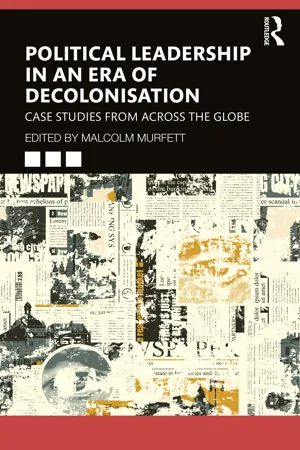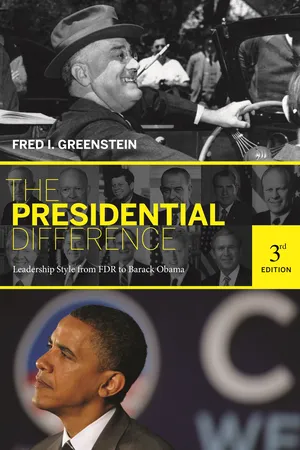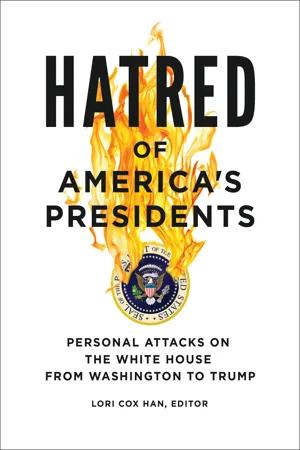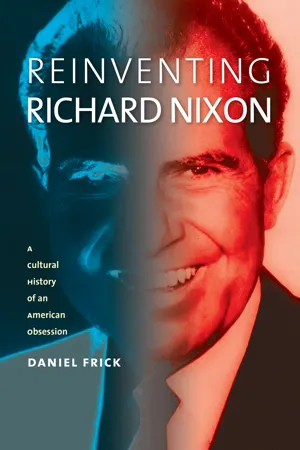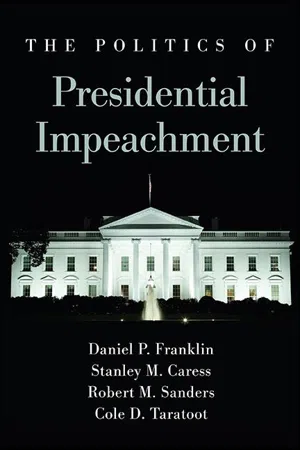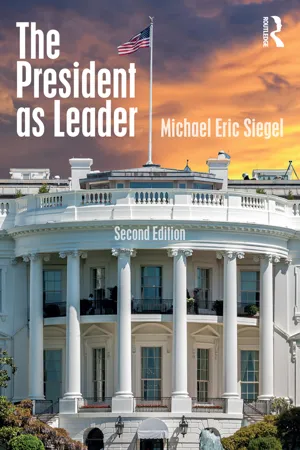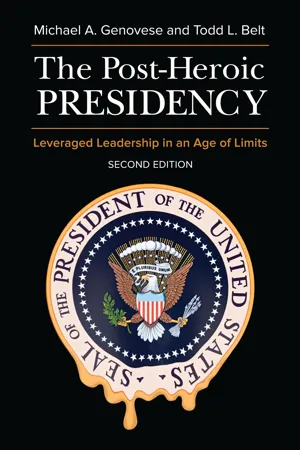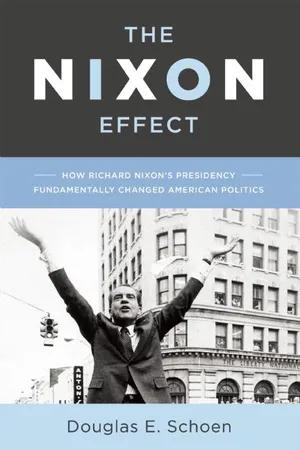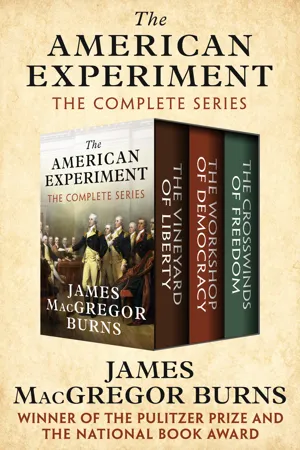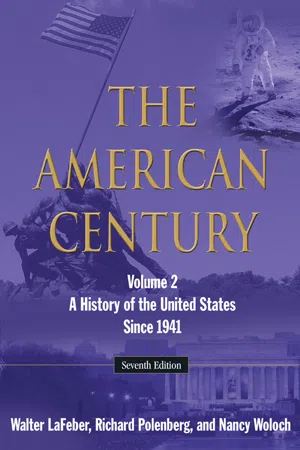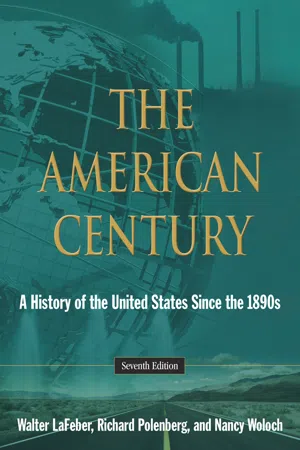History
Richard Nixon
Richard Nixon was the 37th President of the United States, serving from 1969 to 1974. He is known for his foreign policy initiatives, including the normalization of relations with China and the détente with the Soviet Union. However, his presidency was overshadowed by the Watergate scandal, which led to his resignation in 1974, making him the only U.S. president to resign from office.
Written by Perlego with AI-assistance
Related key terms
12 Key excerpts on "Richard Nixon"
- eBook - ePub
Political Leadership in an Era of Decolonisation
Case Studies from Across the Globe
- Malcolm Murfett(Author)
- 2023(Publication Date)
- Routledge(Publisher)
8 The rise and fall of Richard Nixon as a global leader Umberto Tulli DOI: 10.4324/9781003426165-8 Towards the end of his life, Richard Nixon drew a balance of his years at the White House: I will be known historically for two things. Watergate and the opening to China … I don’t mean to be pessimistic, but Watergate, that silly, silly thing, is going to rank up there historically with what I did here. 1 He was not pessimistic at all in making this statement. Watergate obscured much of what he had realised as President, especially in international affairs. By the time of his resignation in August 1974, with the lowest approval rating for a sitting president (a mere 24%), Nixon had achieved several unprecedented advances in foreign policy: détente with the Soviets and international agreements to limit the nuclear race; a redefinition of global financial relations; the end of the Vietnam War; an unprecedented agreement in the Middle East between Egypt and Israel; the opening to the People’s Republic of China; and a new – albeit short-lived – domestic consensus regarding foreign policy. While this record can be accurately characterised as one of the ‘most pro-active and dynamic of the Cold War presidencies,’ as scholar Asaf Siniver wrote, it was nevertheless subject to criticism and, to some extent, proved ephemeral and short-lived. 2 Moreover, most of these initiatives were not radically new. For example, although the Johnson administration was entrapped in the ongoing military escalation in Vietnam, it had been diligently searching for an exit strategy from such a conflict. Similarly, Nixon’s détente with the Soviets was based on policy the Kennedy administration had initiated in the aftermath of the Cuban missile crisis. Although it was proactive, Nixon’s foreign policy was less revolutionary than generally credited, in terms of both means and ends - eBook - ePub
The Presidential Difference
Leadership Style from FDR to Barack Obama - Third Edition
- Fred I. Greenstein(Author)
- 2012(Publication Date)
- Princeton University Press(Publisher)
By the end of his first term, Richard Nixon had extricated the United States from the Vietnam War and transformed his nation’s relations with China and the Soviet Union. A year and a half into his second term, he was forced to resign from office after it became known that he had covered up his administration’s complicity in the 1972 Watergate break-in, lying even to his supporters about having done so. Here Nixon is shown on the final morning of his presidency, boarding the helicopter that took him from the White House grounds on the first leg of his trip to his California home.(National Archives)CHAPTER 7
The Paradox of Richard Nixon
The greatest honor history can bestow is the title of peacemaker. This honor now beckons America—the chance to lead the world at last out of the valley of turmoil and onto that high ground of peace that man has dreamed of since the dawn of civilization.– RICHARD M. NIXON ,INAUGURAL ADDRESS ,JANUARY 20, 1969Let us in these next five days start a long march together. Not in lockstep, but on different roads leading to the same goal: the goal of building a world structure in which all may stand together with equal dignity and in which each nation, large or small, has a right to determine its own form of government free of outside interference or domination.– RICHARD M. NIXON, TOAST AT BANQUET IN THE GREAT HALL OF THE PEOPLE, BEIJING , CHINA ,FEBRUARY 21, 1972I want the most comprehensive notes on all those who tried to do us in. They didn’t have to do it. If we had a very close election and they were playing the other side, I would understand this. No—they were doing this quite deliberately, and they are asking for it, and they are going to get it. We have not used the power in this first four years.… We have not used the [FBI] and we have not used the Justice Department, but things are going to change now.– RICHARD M. NIXON ,WHITE HOUSE TAPE - eBook - ePub
Hatred of America's Presidents
Personal Attacks on the White House from Washington to Trump
- Lori Cox Han(Author)
- 2018(Publication Date)
- ABC-CLIO(Publisher)
37. Richard M. Nixon Born: January 9, 1913 Died: April 22, 1994 Time in Office: 37th President of the United States, January 20, 1969, to August 9, 1974Election Results: 1960 Election: 49.5% of popular vote, 219 (40.8%) Electoral College votes; 1968 Election: 43.4% of popular vote, 301 (55.9%) Electoral College votes; 1972 Election: 60.7% of popular vote, 520 (96.7%) Electoral College votesSpouse: Thelma Catherine “Pat” Ryan (m. 1940) Children: Patricia and JulieFew figures in American life have aroused such strong negative feelings as Richard M. Nixon. Despite his enormous political successes, including one of the largest electoral landslides in the history of presidential elections in 1972, Nixon remained throughout his career the target of public ridicule and animus. Many have sought to account for this curious capacity to mobilize winning popular majorities while simultaneously producing such negative responses. Some point to his psychology, others to his character, and others to lapses in public morality. His supporters maintain that Nixon was opposed, even hated, by liberal elites because he defeated their agenda and represented the voice of the forgotten middle America rather than vocal liberal constituencies such as racial minorities and left-wing activists. But whatever the source for this unique combination of political success and strong political backlash, Nixon became iconic as the corrupt, power-hungry, and ultimately tragically flawed American political leader. As the only president to have ever resigned the office as a result of Watergate, arguably the worst political scandal in modern American history, Nixon was the recipient of a tremendous storm of criticism of sometimes vitriolic intensity. However, Nixon’s acute sense of the animosity directed against him originated well before the Watergate scandal began to be reported in the pages of the Washington Post - eBook - ePub
CultureAmerica
A Cultural History of an American Obsession
- Daniel Frick(Author)
- 2023(Publication Date)
- University Press of Kansas(Publisher)
All can agree, for instance, that Nixon resigned on August 9, 1974, but this point on a timeline is not, by itself, history. History must explain, and an explanation of Nixon’s resignation can only come from telling a story about it. And the shape of the narrative frame into which the details of Richard Nixon’s life will be placed is far from certain. Does Watergate show us that America’s constitutional system can function even when a corrupt president tries to block it? Or does Nixon’s resignation suggest that the electoral process can be circumvented by a cynical political minority and a biased news media? As the critic Stanley Fish tells us, “What is at stake in a disagreement is the right to specify what the facts can hereafter be said to be.” 23 This assertion is what it means to say that history gets written—and rewritten—by the winners of cultural conflict. The disconcerting possibility for the participants in the dispute over Nixon is that their interpretation of his significance to contemporary America may not ever be taken as the truth. This matter is of great consequence, because from the ability to define the past comes control of the stories we use to understand the world in the present. And these narratives lead us to take certain actions that, in turn, help shape the future. Imagine the measures that a nation takes if it believes that it has the most to fear from a powerful executive branch, compared to those that it takes if convinced that its enemies are the liberals and the media. The outcome of the continuing battle over Richard Nixon, therefore, could not be more crucial. The chapters that follow will explore the many faces of Richard Nixon in the continual reinventions of him as a cultural icon - eBook - ePub
- Daniel P. Franklin, Stanley M. Caress, Robert M. Sanders, Cole D. Taratoot(Authors)
- 2020(Publication Date)
- SUNY Press(Publisher)
CHAPTER FOURThe Impeachment and Resignation of Richard Nixon
The presidency of Richard M. Nixon is one of the most complex and contradictory in American history. Nixon is the only president to resign from office under the threat of an impeachment. Yet he was never impeached by the House of Representatives nor convicted by the Senate. Unlike impeachment efforts in the nineteenth century that were mounted against unelected presidents, Nixon was elected by a slim margin to a first term and then reelected by lopsided majorities in both the popular and electoral vote. And yet what was most striking about the Nixon presidency was that the Watergate scandal produced a cascading series of events that led to Nixon’s resignation. And that resignation occurred despite the fact that there wasn’t a hint of question about the legitimacy of the Nixon presidency. Thus, the Nixon impeachment was not so much a constitutional as a political crisis.Presidential impeachment, which had been dormant for over a century, reemerged during Nixon’s second term in office. While on the surface the Nixon case bore little resemblance to any previous presidential impeachment efforts, a thorough review of the conditions that characterized Nixon’s time in office shows that there are some interesting commonalities. Nixon’s presidency at first seemed very unlike that of Andrew Johnson, but a careful look reveals some remarkable parallels.Some of the same factors present in the Johnson impeachment resurfaced during Nixon’s tenure. Both Nixon and Johnson served during intensely emotional times when extreme governmental actions seemed justifiable. The Vietnam War’s level of carnage was devastating, and even though the number of Americans killed in it never approached that of the Civil War, Vietnam divided the country more than any other conflict in over a century. During Nixon’s years in office, the country was still shaken by the assassinations of President John Kennedy, Senator Robert Kennedy, and the Reverend Martin Luther King Jr., just as the country was in mourning for Abraham Lincoln during Johnson’s presidency. And, most critically, both Nixon and Johnson were confronted by a Congress in which the overwhelming number of members were from the opposite party. This was up to this time not the norm in American politics. These and other factors suggest that a thorough analysis will help us understand why presidential impeachment so abruptly reappeared during Nixon’s presidency. - eBook - ePub
- Michael Eric Siegel(Author)
- 2017(Publication Date)
- Routledge(Publisher)
CHAPTER 2Richard Milhous Nixon, Watergate, and the Transformation of the Presidency
Courtesy: Richard Nixon LibraryR ichard Nixon wanted to be the “architect of his times,” according to Elliot Richardson, who held three cabinet posts under Nixon and resigned from the last one for refusing to follow Nixon’s orders to dismiss a Watergate special prosecutor.1 Though he possessed the intellectual power and strategic insight to be such an architect, Nixon did not possess many of the traits normally associated with successful politicians. Remarkably, he was uncomfortable with people and in groups, and was “in his element … alone with his yellow pad and thoughts.”2 Nixon sometimes referred to himself as an “introvert in an extrovert’s business.”3 Political science professor James David Barber, author of the pioneering book The Presidential Character, said that “In essaying Nixon’s personal style the easiest place to begin is with the elimination of personal relations as a primary focus of his energy in adapting to political roles.”4Indeed, Nixon, who ascended to the presidency in January 1969, structured the White House and the executive branch of government in ways that reinforced his preference for isolation and his predilection for centralized power. For instance, only four people had walk-in access to the Oval Office,5 and anyone else—including his cabinet secretaries—who sought an audience with the president would have to arrange an appointment through Nixon’s chief of staff, Bob Haldeman.6 - eBook - ePub
The Post-Heroic Presidency
Leveraged Leadership in an Age of Limits
- Michael A. Genovese, Todd L. Belt(Authors)
- 2016(Publication Date)
- Praeger(Publisher)
CHAPTER 2
Richard M. Nixon Confronts the Early Stages of Decline1
I pledge to you that we shall have an honorable end to the war in Vietnam. —Richard NixonR ichard Nixon inherited a mess. Not only did he face a prolonged war in Vietnam, which seemed all but unwinnable; he was confronted with domestic protest and turmoil of increasing magnitude plus an economy that was sluggish. To make things worse, Nixon also faced the early signs of U.S. international decline.Gone was the euphoria of the Kennedy Camelot years. A new, harsher reality presented itself. The postwar era of U.S. dominance was being challenged by Soviet military power, by a war of national liberation, by economic stagnation, and by domestic discord.Richard Nixon was the first president to govern in the nascent age of limits. In addition to the enormous difficulty of refashioning U.S. policy to meet this new era, Nixon also faced a disjuncture between public attitudes (which continued to embrace the image of the United States as a nearly limitless superpower) and the hard reality of emerging decline (which required downward readjustment). How did Richard Nixon understand the new requirements of this age of limits, and how did he attempt to readjust U.S. policy to meet this new age?FOREIGN AND DEFENSE POLICY
The Nixon years were a time of dramatic, bold, innovative approaches and overtures in the field of foreign affairs. They were years when the conventional wisdom was challenged and when more traditional solutions were eschewed for a new strategic approach to foreign policy.It was a new era that brought about an opening of relations with China, pursued détente, and the Strategic Arms Limitation Treaty (SALT) with the Soviets, a period when the United States’ military involvement in Vietnam and Southeast Asia was expanded, then ended, and when a relatively new approach and strategic orientation was introduced into U.S. foreign policy thinking. - eBook - ePub
Unto a Good Land
A History of the American People, Volume 2: From 1865
- David Edwin Harrell, Edwin S. Gaustad, John B. Boles, Sally Foreman Griffith(Authors)
- 2005(Publication Date)
- Eerdmans(Publisher)
Nixon turned the presidency over to Vice President Gerald R. Ford. Almost as a footnote to the events leading up to Nixon’s resignation, Vice President Agnew had also been forced to resign in 1973, receiving immunity from prosecution after pleading “no contest” to charges of bribe-taking and tax evasion. Ford, the Republican minority leader in the House, had been approved by Congress as the replacement vice president. His appointment in October 1973 was the first usage of the Twenty-Fifth Amendment, adopted in 1967 to provide for filling vice presidential and presidential vacancies.Watergate was one of the American republic’s darkest hours. Twenty-five members of the Nixon administration, including four cabinet officers, were convicted of crimes, and most spent time in prison. Watergate also demonstrated the vitality of American democracy: the nation’s institutions emerged from the crisis largely unscathed. But the price of this demonstration had been high.Nixon’s Departure, August 9, 1974 Bidding farewell to his staff, Richard Nixon waves for the last time from the presidential helicopter before lifting off from the White House. He has just signed his resignation, effective shortly after he will be airborne.AMERICA ON HOLDDistrust of government has long been a part of the national character, but Americans’ cynicism about their country’s political institutions sank to new depths on account of Vietnam and Watergate. To make matters worse, the economic situation continued to deteriorate. The cost of living increased 7 percent in 1973 and skyrocketed 11 percent the following year. Ford, and his successor Jimmy Carter, faced gargantuan problems in trying to rebuild the nation’s international image, stop the economic decline, and heal the nation’s self-inflicted wounds. Both Ford and Carter were men of integrity and ability, but neither could stem the descent into the doldrums at the end of the seventies. - eBook - ePub
The Nixon Effect
How Richard Nixon's Presidency Fundamentally Changed American Politics
- Douglas E. Schoen(Author)
- 2016(Publication Date)
- Encounter Books(Publisher)
At this late date, forty-some years after the fact, and with movies and books enshrining Watergate so deeply in the American political imagination, I confess that it feels somewhat strange to summarize these events, as so many before me have already done. And yet, a generation of Americans has come to maturity knowing of Watergate only as a motif or image for political scandal. They inherited a political system far more partisan and polarized than the one their parents came up in, without really knowing why. So let me summarize the events and history of Watergate briefly—and then discuss what, to me and to many others, seems like the graver crime connected with it.Watergate was, as the Nixon White House infamously attempted to describe it, a “third-rate burglary”10 —in formulation, in tactics, in execution, and most of all in its political goals. During his first term in office, Nixon, increasingly concerned by the release of confidential information—some of it bearing on national security—organized a team, “the plumbers,” to stop leaks. Insiders noted that after Daniel Ellsberg’s publication of the Pentagon Papers in 1971, Nixon became determined to find out what his political adversaries knew.On June 17, 1972, five burglars broke into the headquarters of the Democratic National Committee in the Watergate complex, perhaps seeking information on the Democratic campaign for president that was about to kick off (it was nearly time for the party conventions), though precisely what they were after has been disputed. They bungled the job and were arrested, and it was soon learned that they were working for the Committee to Reelect the President—with the ominous and memorable acronym, CREEP.At first, it seemed that the scandal would not touch Nixon. But in spring 1973, during congressional hearings on the break-in, Alexander Butterfield, a White House deputy, revealed that a taping system had been installed in the Oval Office to record the president’s conversations. Thus, finding out what the president knew about the break-in and what he had done about it would be easy: just listen to the tapes.But Nixon refused to make the tapes available, citing executive privilege. As the months wore on, and more witnesses came before Congress, Nixon’s protestations seemed increasingly suspicious. At Congress’s urging, Attorney General Elliot Richardson had appointed a special prosecutor, Archibald Cox, to investigate any and all crimes committed in the affair. Richardson pledged to Congress that he would not dismiss the special prosecutor, no matter what he uncovered, except for “cause” (gross improprieties or malfeasance). Cox insisted that Nixon give him the tapes, issuing a subpoena for their release, but the president refused. Instead, he offered a review and summary of the tapes’ contents. Cox rejected that proposal. - eBook - ePub
The American Experiment
The Vineyard of Liberty, The Workshop of Democracy, and The Crosswinds of Freedom
- James MacGregor Burns(Author)
- 2013(Publication Date)
- Open Road Media(Publisher)
On July 27, 1974, the committee voted 27-11 to recommend impeachment on the ground that the President had “engaged personally and through his subordinates and agents, in a course of conduct or plan designed to delay, impede, and obstruct the investigation” of the Watergate burglary. Two days later the committee voted, 28-10, an article charging that Nixon’s conduct had violated the constitutional rights of citizens and impaired the proper administration of justice. The votes reflected a precarious coalition of committee Democrats and Republicans; the majority of Republicans still stood by their President.But on August 5, Richard Nixon, in obedience to the Supreme Court decision, released the transcripts of three conversations which showed beyond any doubt that six days after the Watergate break-in—on June 23, 1972—he was at the center of the conspiracy to cover up that crime, obstructing justice by plotting to block the FBI investigation. “I was sick. I was shocked,” a middle-level White House official told a journalist. “He had lied to me, to all of us. I think my first thought, before that sank in, was of those Republicans on the Judiciary Committee … those men who had risked their careers to defend him.”Now one of those men—Charles Wiggins—said, “I have reached the painful conclusion that the President of the United States should resign.” If he did not, “I am prepared to conclude that the magnificent career of public service of Richard Nixon must be terminated involuntarily.”The White House, August 7-9, 1974. In the final days the two Nixons—the shrewd, confident calculator and the narcissist hovering between dreams of omnipotence and feelings of insecurity—emerged in the Watergate crucible. Even now he was a cold head counter, yet he appeared to be swinging erratically between holding out to the bitter end and throwing it all up. Senators Barry Goldwater and Hugh Scott and House Minority Leader John J. Rhodes arrived at the White House on August 7 to brief the President on the situation in Congress. After some small talk:SCOTT: We’ve asked Barry to be our spokesman.NIXON: GO ahead, Barry.GOLDWATER: - eBook - ePub
The American Century
A History of the United States Since 1941: Volume 2
- Walter LaFeber, Richard Polenberg, Nancy Woloch(Authors)
- 2015(Publication Date)
- Routledge(Publisher)
Finally, on the night of August 7, Nixon met with two conservative Arizona Republicans, Senator Barry Goldwater and Representative John Rhodes, the House minority leader. They reported that the Senate would surely vote to convict. Even the ten Republican members of the Judiciary Committee who had defended the president a few days earlier had reversed their positions. One member reportedly asked if the committee could reconvene so he could change his vote, but he was informed, “the train had left the station.” Its destination became known on August 9, 1974, when for the first time in history an American president resigned his office. Vice President Gerald Ford, whom Nixon had appointed to replace Agnew, became chief executive.Within a month, Ford unilaterally used his new power to protect Nixon from criminal prosecution. On September 8, 1974, the president said that he was pardoning Nixon for all federal crimes he “committed or may have committed” during his years in the White House. Ford’s announcement set off a storm of protest since it precluded a trial and thereby undercut proper legal processes. Two years later, the pardon became an important reason why many Americans preferred Jimmy Carter instead of Ford in the presidential election. The ghost of Richard Nixon continued to stalk the corridors of American politics.HENRY KISSINGER: FOREIGN POLICY FROM NIXON TO FORD
One official, however, emerged from the morass of Watergate with an enhanced reputation. In 1973, after having served as the president’s national security adviser, Henry Kissinger became secretary of state. That same year he finally succeeded in negotiating a Vietnam cease-fire with his North Vietnamese counterpart, Le Due Tho. The two men were rewarded with the 1973 Nobel Peace Prize. Tho refused his share, correctly asserting that war between North and South Vietnam continued. The American troops left, however, and Kissinger accepted his share of the prize. “Half a prize for half a peace seems just about right,” one journalist observed.Kissinger followed the cease-fire with equally successful (from his and Nixon’s view), if less publicized, diplomacy in Chile. Since 1970 President Salvador Allende had turned Chile toward a nationalist, independent course and attempted to gain his nation’s economic independence—and distribute its wealth more equitably—by seizing property owned by North American corporations and wealthy Chileans. Kissinger and Nixon secretly moved to undermine the new regime. By 1973 Allende’s government suffered severely not only from its own economic errors, but also from a cutoff of the U.S. aid on which Chile had long depended. Kissinger meanwhile strengthened Washington’s ties with the Chilean army. In September 1973 the army struck. Overthrowing Allende, who died in the struggle, the army ended all attempts at reform, established a military regime, and then tortured and murdered thousands of political prisoners. Both North and South Americans were alarmed by Chile’s new course, but Kissinger and Nixon were pleased that they had played a major part in overthrowing a government they had always mistrusted and feared. - eBook - ePub
The American Century
A History of the United States Since the 1890s
- Walter LaFeber, Richard Polenberg, Nancy Woloch(Authors)
- 2015(Publication Date)
- Routledge(Publisher)
Finally, on the night of August 7, Nixon met with two conservative Arizona Republicans, Senator Barry Goldwater and Representative John Rhodes, the House minority leader. They reported that the Senate would surely vote to convict. Even the ten Republican members of the Judiciary Committee who had defended the president a few days earlier had reversed their positions. One member reportedly asked if the committee could reconvene so he could change his vote, but he was informed, "the train had left the station." Its destination became known on August 9, 1974, when for the first time in history an American president resigned his office. Vice President Gerald Ford, whom Nixon had appointed to replace Agnew, became chief executive.Within a month, Ford unilaterally used his new power to protect Nixon from criminal prosecution. On September 8, 1974, the president said that he was pardoning Nixon for all federal crimes he "committed or may have committed" during his years in the White House. Ford's announcement set off a storm of protest since it precluded a trial and thereby undercut proper legal processes. Two years later, the pardon became an important reason why many Americans preferred Jimmy Carter instead of Ford in the presidential election. The ghost of Richard Nixon continued to stalk the corridors of American politics.Henry Kissinger: Foreign Policy from Nixon to Ford
One official, however, emerged from the morass of Watergate with an enhanced reputation. In 1973, after having served as the president's national security adviser, Henry Kissinger became secretary of state. That same year he finally succeeded in negotiating a Vietnam cease-fire with his North Vietnamese counterpart, Le Due Tho. The two men were rewarded with the 1973 Nobel Peace Prize. Tho refused his share, correctly asserting that war between North and South Vietnam continued. The American troops left, however, and Kissinger accepted his share of the prize. "Half a prize for half a peace seems just about right," one journalist observed.Kissinger followed the cease-fire with equally successful (from his and Nixon's view), if less publicized, diplomacy in Chile. Since 1970 President Salvador Allende had turned Chile toward a nationalist, independent course and attempted to gain his nation's economic independence—and distribute its wealth more equitably—by seizing property owned by North American corporations and wealthy Chileans. Kissinger and Nixon secretly moved to undermine the new regime. By 1973 Allende's government suffered severely not only from its own economic errors, but also from a cutoff of the U.S. aid on which Chile had long depended. Kissinger meanwhile strengthened Washington's ties with the Chilean army. In September 1973 the army struck. Overthrowing Allende, who died in the struggle, the army ended all attempts at reform, established a military regime, and then tortured and murdered thousands of political prisoners. Both North and South Americans were alarmed by Chile's new course, but Kissinger and Nixon were pleased that they had played a major part in overthrowing a government they had always mistrusted and feared.
Index pages curate the most relevant extracts from our library of academic textbooks. They’ve been created using an in-house natural language model (NLM), each adding context and meaning to key research topics.
